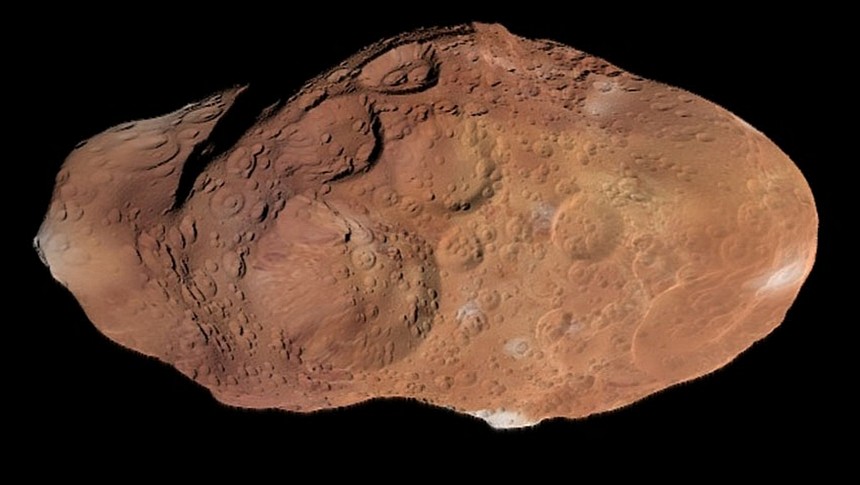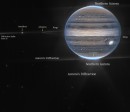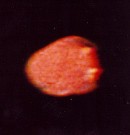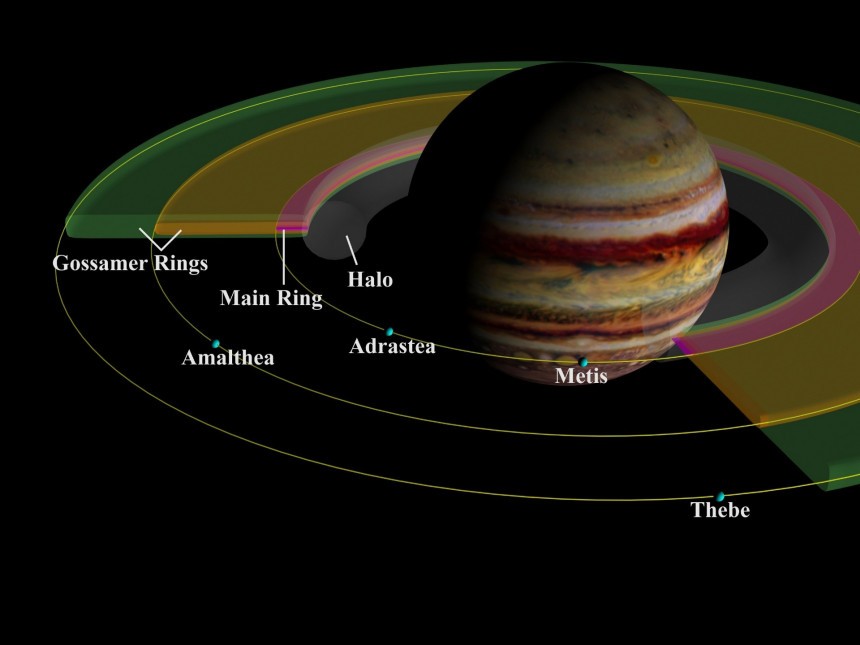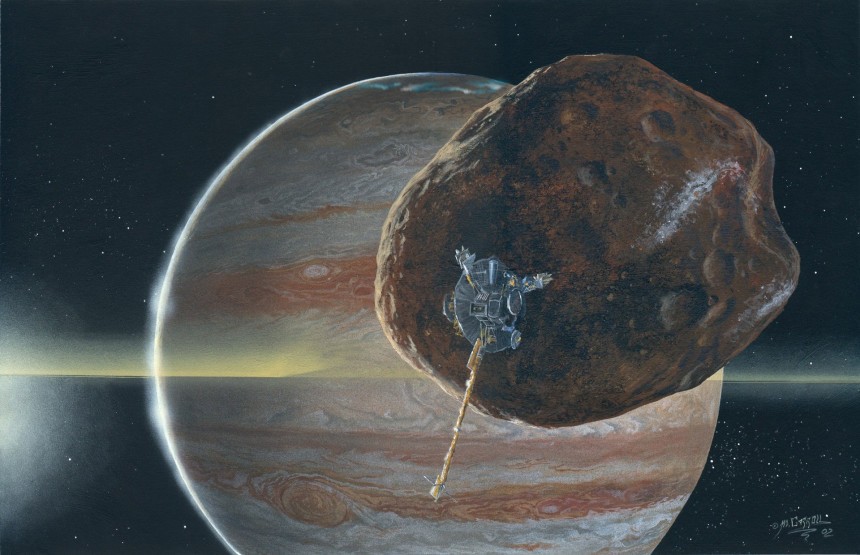Almost everyone knows that Jupiter has more moons than it probably knows what to do with—Ninety-five and counting as of the last estimates. But if you ask most folks, they'll only be able to call out a select four Jovian moons if they have to bring them to mind. Europa, Io, Calisto, and Ganymede, collectively known as the Galenian moons, have been the darlings of interplanetary space probes and stalwarts of the modern discourse around space culture.
It may be time to show other objects out there in the Jovian system some love. Because as you'll find, not every moon in this system is the same any more than the Galilean moons are the same. This is Amalthea, and if there were a single non-Galenian Jovian moon one could point to as the most interesting in the entire system, this would likely be our pick.
First discovered on September 9th, 1892, by the renowned American Astronomer Edward Emmerson Barnard at the University of California's Lick Observatory, Amalthea is so much more than a lump of rock and metal that happened to be captured by Jupiter's immense gravity. As the last natural satellite in the Solar System to be discovered and cataloged through direct telescope observation instead of through the analysis of photographs after the fact, Amalthea marked the end of a centuries-long era of Solar System observation that stretched back to even before the time of Galileo Galilei.
Amalthea's discovery also marked the first Jovian satellite object confirmed to exist since the time of Galileo. Its name is derived from the character of Greek mythology who served as one of Zeus' foster mothers who nursed the young god with goat milk and is depicted as a nurturing goddess who tended fields of goats in the realm of the Greek gods, Amalthea's orbit is the third closest to Jupiter by terms of apoapsis (farthest approach) and periapsis (nearest approach).
The only two moons that orbit closer are Adrastea and Thebe, of which the former is considerably smaller than Amalthea, the smallest Jovian moon in the system, and the latter wasn't discovered and identified until 1979. During its closest interaction with Jupiter along its orbital path, Amalthea comes within 181,000 km (112,468.18 mi) of the farthest reaches of Jupiter's upper atmosphere. For some context, that's coming up on half the distance between the Earth and our Moon.
As a result, Arimathea plays a fitting host to some of the most breathtaking views in this little corner of the Milky Way. Being so close to what is more or less a failed star of a gas giant, great swaths of the inky black cosmos are nearly totally obscured by an 88,695-mile (142,800-km) colossus of swirling gas and endless rampaging storms. From this vantage point, infrared imaging equipment would allow Jupiter's faint but substantial ring system to be focused, as was demonstrated when the James Webb Space Telescope accomplished the same feat from Earth's L2 LaGrange point.
Apart from the views, the geological makeup of Amalthea is far more fascinating than its diminutive size might lead. With its highly peculiar shape mimicking a giant floating space potato, precise measurements of Amalthea's surface area are quite difficult. But so far as modern science can ascertain, current estimates peg the number at somewhere between 88,000 and 170,000 square km (33,977-65,693.3 sq-mi), with a sweet spot somewhere in the vicinity of 130,000 square km (50,193.3 sq-mi) or just a little bit smaller than the surface area of New York State, or Switzerland, the Netherlands, Belgium, and Luxembourg put together.
But both inside and on the surface of Amalthea are bursting up to the gills with potential scientific discoveries. Though black and white satellite photos may not indicate it, the moon's surface is a magnificent red color which, had you not known any better, could have been mistaken for a wayward piece of Mars flung off eons ago by some cataclysmic impact event. But no, any resemblance to a chunk of the Red Planet is only superficial. So far as scientists can surmise, the color might come from sulfur emissions ejected from the Galenian moon Io's relentless volcanic onslaught.
For the moment, the answer to the red color question remains unsolved. But it's plain to see that Amalthea's surface doesn't look too far off from that of our own Moon but scaled down substantially. With a surface deeply pitted with impact craters creating massive leviathans of mountains and valleys that mimic a scaled-down Grand Canyon, Amalthea's proximity to Jupiter can and does cause havoc on the tiny moon. Its blisteringly fast orbital time around Jupiter of just under half of an Earth day is a feat within itself.
Scientists can't say the origins of Amalthea for sure. But a theorized abundance of water ice housed deep within the moon could suggest it originates from somewhere other than the Jovian system. Such water ice would've instantly vaporized had Amalthea been around for Jupiter's hot, violent beginnings as a failed star. But it can't be argued that if a human-crewed spacecraft were taking a grand trip across the Galilean Moons and fancied Amalthea as a side quest of sorts, the views and experience would be nothing short of biblical.
But if human astronauts managed to land on Amalthea, their spacesuit's sensors might find the ambient temperature of the rocky surface to be a bit warmer than one might expect in the cold expanse of the cosmos. That's because, for reasons that aren't yet clear, Amalthea appears to generate just as much, if not more, heat internally than it receives from the Sun. Increased influence by Jupiter's own heat cycle might account for a portion of explaining the strange phenomenon, as could charged sub-atomic particle bombardment from interstellar space.
One thing's for sure, none of this could be properly verified until close-up interactions with human-built space probes could determine the truth. The first two probes to get up close and personal with Amalthea were the twin Voyager probes one and two in 1979. As the two probes conducted their exploration of Jupiter's moons, once totally unknown aspects of its makeup honed into view for the first time in history. It was here that Amalthea's prominent features, like the 75-km wide Gaea crater and the 20-kilometer-tall Lyctos Facula mountain range, made themselves known to mankind. Voyager's heat sensors also gave valuable insight into the moon's peculiar surface temperature.
It'd take until 2002 for the moon to be studied closely by human-made probes when the Galileo mission observed Amalthea from a distance of 244 km (152 mi) and completed the mapping mission begun by the Voyager probes. As for future missions, the prospects remain unclear. But should more probes or even a lander be sent to Amalthea one day, the first priority would likely be to determine its exact chemical makeup. For example, suppose theorized deposits of water ice can be found.
In that case, the potential to convert this into drinkable water and useable rocket fuel for future human-crewed missions gives Amalthea a scientific capacity you might not expect from a rocky potato in Jovian orbit. Furthermore, more information on how a moon with such a low relative density managed to survive this close to Jupiter would be a top priority for any future mission that crosses Amalthea's path. For all these reasons, it makes logical sense that the next mission to study the Galilean moons takes on Amalthea as a secondary objective with just as much potential for scientific discovery as larger moons.
But for now, no mission set to launch any time soon fits this description, meaning Amalthea is likely to remain the Jovian system's most under-the-radar enigma for decades to come. But hey, that isn't necessarily set in stone. One thing is certain, we're all pulling for NASA and its partners to make it happen.
First discovered on September 9th, 1892, by the renowned American Astronomer Edward Emmerson Barnard at the University of California's Lick Observatory, Amalthea is so much more than a lump of rock and metal that happened to be captured by Jupiter's immense gravity. As the last natural satellite in the Solar System to be discovered and cataloged through direct telescope observation instead of through the analysis of photographs after the fact, Amalthea marked the end of a centuries-long era of Solar System observation that stretched back to even before the time of Galileo Galilei.
Amalthea's discovery also marked the first Jovian satellite object confirmed to exist since the time of Galileo. Its name is derived from the character of Greek mythology who served as one of Zeus' foster mothers who nursed the young god with goat milk and is depicted as a nurturing goddess who tended fields of goats in the realm of the Greek gods, Amalthea's orbit is the third closest to Jupiter by terms of apoapsis (farthest approach) and periapsis (nearest approach).
The only two moons that orbit closer are Adrastea and Thebe, of which the former is considerably smaller than Amalthea, the smallest Jovian moon in the system, and the latter wasn't discovered and identified until 1979. During its closest interaction with Jupiter along its orbital path, Amalthea comes within 181,000 km (112,468.18 mi) of the farthest reaches of Jupiter's upper atmosphere. For some context, that's coming up on half the distance between the Earth and our Moon.
Apart from the views, the geological makeup of Amalthea is far more fascinating than its diminutive size might lead. With its highly peculiar shape mimicking a giant floating space potato, precise measurements of Amalthea's surface area are quite difficult. But so far as modern science can ascertain, current estimates peg the number at somewhere between 88,000 and 170,000 square km (33,977-65,693.3 sq-mi), with a sweet spot somewhere in the vicinity of 130,000 square km (50,193.3 sq-mi) or just a little bit smaller than the surface area of New York State, or Switzerland, the Netherlands, Belgium, and Luxembourg put together.
But both inside and on the surface of Amalthea are bursting up to the gills with potential scientific discoveries. Though black and white satellite photos may not indicate it, the moon's surface is a magnificent red color which, had you not known any better, could have been mistaken for a wayward piece of Mars flung off eons ago by some cataclysmic impact event. But no, any resemblance to a chunk of the Red Planet is only superficial. So far as scientists can surmise, the color might come from sulfur emissions ejected from the Galenian moon Io's relentless volcanic onslaught.
For the moment, the answer to the red color question remains unsolved. But it's plain to see that Amalthea's surface doesn't look too far off from that of our own Moon but scaled down substantially. With a surface deeply pitted with impact craters creating massive leviathans of mountains and valleys that mimic a scaled-down Grand Canyon, Amalthea's proximity to Jupiter can and does cause havoc on the tiny moon. Its blisteringly fast orbital time around Jupiter of just under half of an Earth day is a feat within itself.
But if human astronauts managed to land on Amalthea, their spacesuit's sensors might find the ambient temperature of the rocky surface to be a bit warmer than one might expect in the cold expanse of the cosmos. That's because, for reasons that aren't yet clear, Amalthea appears to generate just as much, if not more, heat internally than it receives from the Sun. Increased influence by Jupiter's own heat cycle might account for a portion of explaining the strange phenomenon, as could charged sub-atomic particle bombardment from interstellar space.
One thing's for sure, none of this could be properly verified until close-up interactions with human-built space probes could determine the truth. The first two probes to get up close and personal with Amalthea were the twin Voyager probes one and two in 1979. As the two probes conducted their exploration of Jupiter's moons, once totally unknown aspects of its makeup honed into view for the first time in history. It was here that Amalthea's prominent features, like the 75-km wide Gaea crater and the 20-kilometer-tall Lyctos Facula mountain range, made themselves known to mankind. Voyager's heat sensors also gave valuable insight into the moon's peculiar surface temperature.
It'd take until 2002 for the moon to be studied closely by human-made probes when the Galileo mission observed Amalthea from a distance of 244 km (152 mi) and completed the mapping mission begun by the Voyager probes. As for future missions, the prospects remain unclear. But should more probes or even a lander be sent to Amalthea one day, the first priority would likely be to determine its exact chemical makeup. For example, suppose theorized deposits of water ice can be found.
But for now, no mission set to launch any time soon fits this description, meaning Amalthea is likely to remain the Jovian system's most under-the-radar enigma for decades to come. But hey, that isn't necessarily set in stone. One thing is certain, we're all pulling for NASA and its partners to make it happen.
